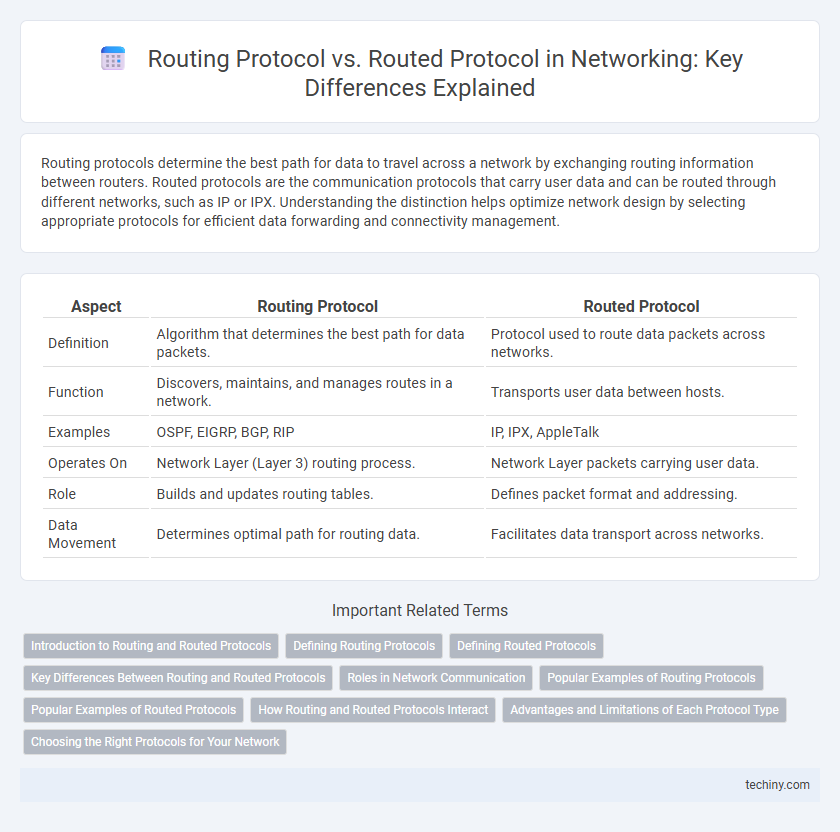Routing protocols determine the best path for data to travel across a network by exchanging routing information between routers. Routed protocols are the communication protocols that carry user data and can be routed through different networks, such as IP or IPX. Understanding the distinction helps optimize network design by selecting appropriate protocols for efficient data forwarding and connectivity management.
Table of Comparison
| Aspect | Routing Protocol | Routed Protocol |
|---|---|---|
| Definition | Algorithm that determines the best path for data packets. | Protocol used to route data packets across networks. |
| Function | Discovers, maintains, and manages routes in a network. | Transports user data between hosts. |
| Examples | OSPF, EIGRP, BGP, RIP | IP, IPX, AppleTalk |
| Operates On | Network Layer (Layer 3) routing process. | Network Layer packets carrying user data. |
| Role | Builds and updates routing tables. | Defines packet format and addressing. |
| Data Movement | Determines optimal path for routing data. | Facilitates data transport across networks. |
Introduction to Routing and Routed Protocols
Routing protocols, such as OSPF and BGP, enable routers to dynamically discover and maintain network paths by exchanging routing information. Routed protocols, including IP and IPX, carry user data across these established routes by encapsulating packets with addressing and control information. Understanding the distinction between routing protocols that determine the best path and routed protocols that deliver the actual data is essential for efficient network design and management.
Defining Routing Protocols
Routing protocols are algorithms used by routers to dynamically discover and maintain routes within a network, enabling efficient data packet forwarding. These protocols exchange information about network topology, allowing routers to make informed decisions on the best path for data transmission. Examples of routing protocols include OSPF, EIGRP, and BGP, each designed to optimize network routing performance and scalability.
Defining Routed Protocols
Routed protocols are network layer protocols that carry user data and provide addressing schemes to deliver packets across diverse networks. Examples include Internet Protocol (IP), Internetwork Packet Exchange (IPX), and AppleTalk, which specify how data is encapsulated and routed through network devices. These protocols operate independently of routing protocols and are essential for enabling data communication between hosts.
Key Differences Between Routing and Routed Protocols
Routing protocols, such as OSPF, EIGRP, and BGP, are used to discover and maintain routes within or between networks by exchanging routing information among routers. Routed protocols like IP or IPX carry user data packets based on logical addressing but rely on routing protocols to determine the best path. The key difference lies in routing protocols managing the path selection process, while routed protocols are responsible for packet forwarding across the established routes.
Roles in Network Communication
Routing protocols determine the best path for data packets to travel across complex networks by exchanging routing information between routers. Routed protocols carry the user data from source to destination by defining packet formats and addressing schemes within the network. The interaction between routing protocols and routed protocols ensures efficient data delivery and dynamic network communication management.
Popular Examples of Routing Protocols
Routing protocols like OSPF, EIGRP, and BGP dynamically determine the best paths for data packets across networks by exchanging routing information between routers. In contrast, routed protocols such as IP or IPX are responsible for carrying user data and rely on routing protocols to establish the path for data transmission. Popular routing protocols include OSPF, widely used for its link-state algorithm; EIGRP, known for its efficiency in Cisco environments; and BGP, essential for routing between autonomous systems on the internet.
Popular Examples of Routed Protocols
Routed protocols such as Internet Protocol (IP), Internetwork Packet Exchange (IPX), and AppleTalk enable data packets to be forwarded between networks using routing tables. Commonly implemented in modern networks, IP remains the predominant routed protocol driving internet communication. Understanding popular routed protocols is essential for configuring and troubleshooting network devices effectively.
How Routing and Routed Protocols Interact
Routing protocols dynamically exchange network topology information among routers to determine optimal paths, enabling efficient data forwarding. Routed protocols carry the user data packets by utilizing the paths established through routing protocols. Interaction between routing and routed protocols ensures seamless packet delivery across diverse network segments by combining route determination with actual data transmission.
Advantages and Limitations of Each Protocol Type
Routing protocols, such as OSPF and BGP, enable routers to dynamically share network topology information, offering scalability and adaptability to network changes but may introduce complexity and require more processing power. Routed protocols like IP and IPX define the packet formats and addressing schemes used for actual data transfer across networks, providing a stable mechanism for end-to-end communication but lacking the capability to determine optimal paths independently. The combination of routing and routed protocols ensures efficient data delivery while balancing the demands of routing decision-making and packet forwarding.
Choosing the Right Protocols for Your Network
Selecting the appropriate routing protocol such as OSPF or EIGRP ensures efficient path determination and dynamic route updates across your network. Routed protocols like IP or IPX define the data packet formats and must be supported by your routing protocols to enable successful packet forwarding. Understanding the distinction and compatibility between routing and routed protocols optimizes network performance, scalability, and reliability.
Routing Protocol vs Routed Protocol Infographic

 techiny.com
techiny.com